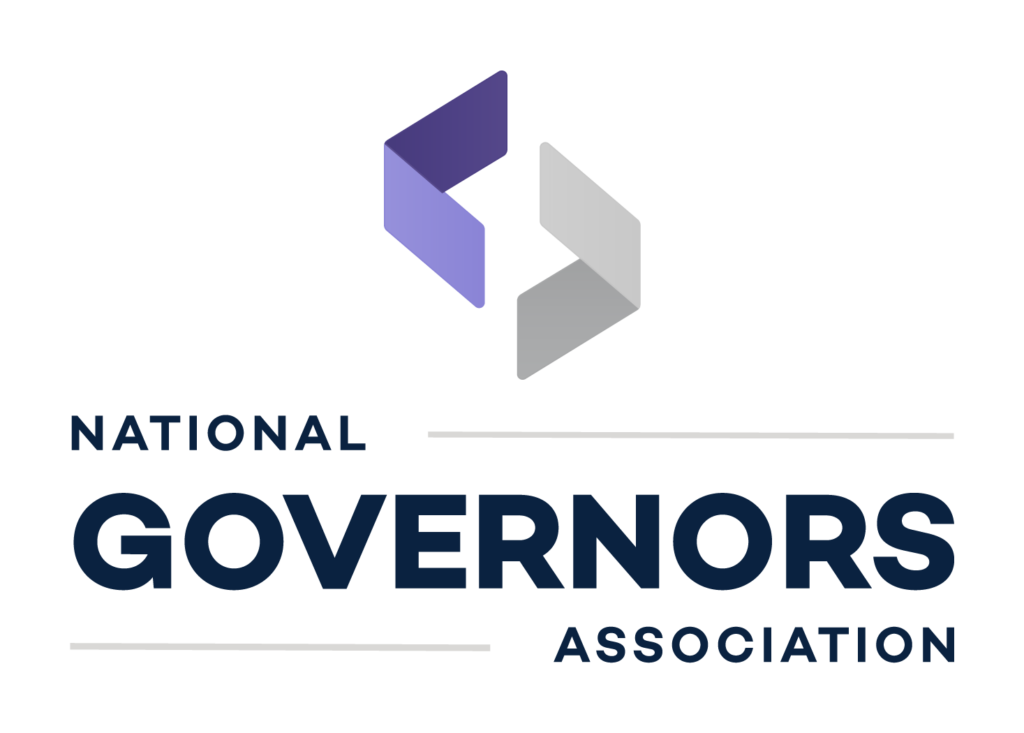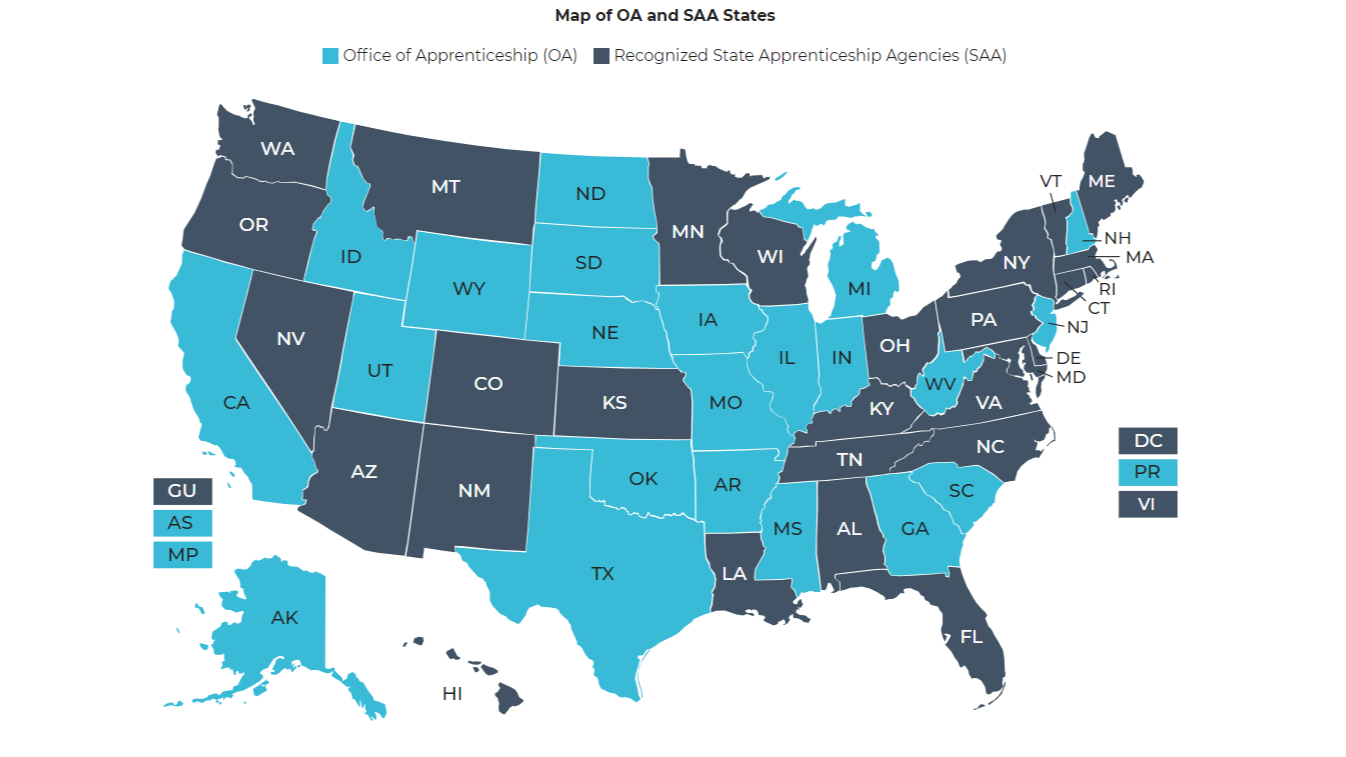This publication highlights the significance of Registered Apprenticeship Programs (RAPs) as one of several strategies and opportunities that employers and states can implement and offer to individuals as a viable path toward securing and prospering in a career.
(Download)
Registered Apprenticeship has and will continue to play an important role in the U.S. economy and workforce ecosystem by satisfying employer talent needs while providing training and employment pathways for individuals in family-sustaining, in-demand careers. A registered apprenticeship is an intensive program that offers an individual paid on-the-job experience, coupled with classroom learning that together provides a jobseeker with the necessary skills to secure gainful employment. This publication highlights the significance of Registered Apprenticeship Programs (RAPs) as one of several strategies and opportunities that employers and states can implement and offer to individuals as a viable path toward securing and prospering in a career.
RAPs are beneficial for both employers and apprentices, including through the development of a steady talent pipeline, decreased turnover, improved productivity, and a diversification among teams, with a notable 44 percent return on investment for employers. There is recent momentum in registered apprenticeships across diverse sectors, due to factors such as a tight labor market, the rising cost of traditional post-secondary education, and the demand for a more skilled workforce. States across the country including Michigan, Alabama, and Maryland have successfully expanded RAPs by providing direct support to employers, aligning efforts between multiple state agencies, and capitalizing on federal funding opportunities. Several states have partnered with employers like Pfizer, Huntington Ingalls Industries and AT&T to promote and expand Registered Apprenticeship. Continued collaboration between states and employers, regardless of their size or location, is necessary to adapt and scale RAPs in in-demand and non-traditional sectors in response to the evolving economic and workforce landscape.


What is a Registered Apprenticeship?
Registered Apprenticeship is a workforce training program where individuals can obtain employer-funded work experience, mentorship, progressive wage increases, classroom instruction, and a portable, nationally-recognized credential. Apprenticeship programs can be registered through the Office of Apprenticeship at the U.S. Department of Labor (DOL) or a U.S. DOL-approved State Apprenticeship Agency (SAA) and must meet federal requirements designed to assure quality, safety and wage standards, and relevance to industry.
Recent Momentum in Registered Apprenticeship
Earn and learn training programs are a pillar of workforce development and are successful in a variety of forms. Registered apprenticeships, on-the-job worker training, paid internships, and other work-based learning opportunities all connect employers to a workforce that is actively gaining skills, which lowers the level of investment required when recruiting and hiring an individual who has the exact skills on day one. For participants — whether high school students, individuals re-entering the workforce, those currently in the workforce looking to upskill, or anyone in between — earn and learn training programs provide firsthand career exposure and skill development that is directly tied to an industry or employer.
Generally viewed as the gold standard of earn and learn models, the benefits of RAPs are numerous for both the apprentice and the employer. For employers, a successful RAP can provide a steady pipeline of skilled talent, decrease turnover, improve productivity, and create intergenerational and more diverse teams. A 2022 study by Abt Associates found that “for every dollar invested in an apprentice, the employer ultimately earns $1.44 in benefits — a 44 percent return on investment.” While being paid to work, apprentices also receive related technical instruction, mentorship and, once completed, a transferable, industry-recognized credential of value. There are, of course, costs incurred by the employer and others in creating and mobilizing a RAP, but there is broad agreement that the benefits outweigh the costs for both employers and apprentices.
Registered Apprenticeship Benefits for Employers

Improved pipeline of skilled workers

Higher employee retainment

Reduced downtime due to recruitment and hiring

Reduced overtime for existing staff

Improved company culture

Product or process innovation

Intergenerational teams promoting knowledge transfer

Improved co-worker productivity
Since Congress passed the National Apprenticeship Act in 1937, states across the country have leveraged Registered Apprenticeship to varying degrees during times of economic expansion and contraction. Currently, the country is experiencing a significant expansion of Registered Apprenticeship, in both traditional sectors, such as construction, as well as non-traditional fields, such as information technology, healthcare and teaching. Between 2012 and 2021, the U.S. saw a 64 percent increase in new Registered Apprentices with over 14,700 new RAPs. There are several factors that contribute to this expansion, including a tight labor market, increasing cost of other post-secondary educational programs (namely bachelor’s degrees), a higher level of skills-based hiring not tied to degrees, as well as the demand for a more skilled workforce by employers.
Structure of State and Territory Apprenticeship Systems
Depending on the state or territory, the apprenticeship system is either governed by the U.S. DOL Office of Apprenticeship (OA) or a recognized SAA. Both entities fill the same role of registering and overseeing RAPs but do differ in a few key ways, which can impact the timeline and nature of how an employer interacts with the registering entity.
| U.S. DOL Office of Apprenticeship | State Apprenticeship Agency | |
|---|---|---|
| Registering Apprenticeship Programs | Through field offices, U.S. DOL registers and oversees programs in states and territories without a recognized SAA. | Acts on behalf of U.S. DOL to register and oversee programs in the state or territory. |
| Staffing | U.S. DOL federal employees | State/territory employees |
| Documentation and Reporting | Programs are all registered through standard documentation. This includes things such as the apprenticeship approach (time-based, hybrid, or competency-based) and time requirements, work process schedule, related technical instruction, apprenticeship wage schedule and other required documentation. | Can use the standard documentation from the federal system or documentation specific to the state or territory. For instance, Wisconsin requires employers to use the Bureau of Apprenticeship Standards Electronic Registration System (BASERS) to register new apprentice contracts. |
| Data and Compliance | Uses the Registered Apprenticeship Partners Information Data System (RAPIDS) for registration, oversight, tracking and compliance. Information in RAPIDS includes apprentice demographic data, occupation data, completion information, union vs. non-union apprentices and much more. | Can use the RAPIDS or can use a unique state system. As of the last reporting (2021), 12 states/territories do not use RAPIDS to track RAP data. |
Generally, employers that register an apprenticeship program will have to complete similar steps regardless of the state or territory. However, the exact requirements and documentation will depend on whether the state or territory the program is being registered in operates an OA or an SAA. To ensure compliance and successful registration, a company or organization can contact the applicable state office. It is important to note that a company that is registering a program across multiple states or territories that do not all operate an OA must register the program in each state that operates as an SAA.

Promising State Policies and Programs to Support Employer Led RAPs
Whether operating an OA or SAA, states and territories have taken efforts to promote RAPs and lower barriers employers encounter when registering a program. Funding for these efforts executed by states often come in the form of DOL grants, but states such as South Dakota and Pennsylvania are also appropriating their own funds to grow RAPs. Michigan, Alabama and Maryland each have undertaken exemplary efforts to expand RAPs in their states through innovative policies and programs that make the registration process smoother and more accessible to large and small employers alike. While this publication highlights these three states, many other states and territories are working within their own systems to expand RAPs and simplify the process. Lessons learned and best practices can be shared across systems to allow employers to easily develop and expand programs without additional administrative burden.
Michigan – Providing Technical Expertise to Create and Sustain RAPs

Michigan, which partners with U.S. DOL to operate as an OA state, goes to great lengths to expand and promote RAPs. Through the State Apprenticeship Expansion office and the Michigan Apprenticeship Advisory Board (comprised of representatives of employers, labor, education and workforce), the state has coordinated efforts and offers direct, tailored support to employers and other system partners at a local level. Michigan supports employers through Apprenticeship Success Coordinators who are tasked with assisting companies in developing and executing a RAP as well as connecting career seekers to apprenticeship opportunities.
Each one of the 16 local Michigan Works! agencies has a designated Apprenticeship Success Coordinator funded through a variety of state and federal dollars, including the federal Workforce Innovation and Opportunity Act (WIOA). In practice, an Apprenticeship Success Coordinator reduces the time and effort (and thus costs) an employer expends on registration, recruitment, and administration by guiding them from inception to completion. The coordinators can also act as facilitators between employers and the partners that are necessary to develop and scale RAPs. Additionally, through their intimate work with employers, the Apprenticeship Success Coordinators are well-positioned to link job seekers to a RAP that suits an individual’s skills, training needs and career goals. Through direct support, Michigan’s Apprenticeship Success Coordinators demystify the apprenticeship registration process and troubleshoot issues as they arise, ensuring employers have all they need to create and execute a successful RAP. The impact of this direct support is especially seen in non-traditional apprenticeship sectors that have gone from 16.6 percent of all new apprentices between 2008-2017 to 25.2 percent between 2018-2021.
One of the non-traditional apprenticeship sectors with which Michigan has found success is pharmaceuticals in partnership with Pfizer. Pfizer’s Kalamazoo site has graduated more than 200 apprentices through nine Registered Apprenticeship programs. As a result of working with community partners like school districts, community colleges, and educationally focused non-profits, the company has reported an increased interest in these apprenticeable, high-demand careers. Pfizer Kalamazoo has directly invested in Registered Apprenticeship and has recognized the benefits that it provides for future generations as well as the impact that it can have to ensure Pfizer remains a global leader in this sector. They recently worked with their local workforce development board Apprenticeship Success Coordinator to achieve funding through Michigan’s Going PRO Talent Fund to reimburse a portion of the related instruction costs for 24 Registered Apprentices in the 2023-2024 cycle. Additionally, Pfizer continues to engage with local community partners along the earn and learn spectrum to grow interest and broaden the talent pool for careers that are in dire need of skilled talent.
Alabama – Interagency Collaboration to Drive Participation

As RAPs are both a workforce and educational opportunity, they require a high level of collaboration and coordination between various state agencies. Alabama, which operates an SAA through the Alabama Office of Apprenticeship, has emphasized the importance of alignment between agencies that interact with RAPs to ensure that employers can successfully develop programs and that individuals are able to enroll in and complete them.
Under Governor Kay Ivey’s direction, several agencies have coordinated efforts over the past six years to create a system that is responsive to the needs of employers and students alike. This coordination has included the Governor’s Office of Education and Workforce Transformation, the Alabama Departments of Commerce, Labor and Education, the Alabama Community College System, the Alabama Commission on Higher Education, and others.
Alabama’s statewide Success Plus goal, to add 500,000 individuals with postsecondary credentials to the state’s workforce by 2025, has prompted each of the above departments to better align their efforts, ensuring the individuals who complete training are receiving a credential valued by employers. To promote Registered Apprenticeship as one of these valued credentials, the state has created an employer incentive that reimburses 50 percent of the wages paid to an apprentice (up to 480 hours) in a new RAP, which they have found to be twice as effective as a traditional tax incentive. In addition to directly supporting employers, the Office of Apprenticeship has worked closely with the community college system and a number of four-year institutions to give class credit to apprentices who have proven they have gained the requisite competencies, such as the agreement between Troy University and Wallace Community College for the Early Childhood Education apprenticeship program.
Employers are similarly promoting the connection between education and the workforce, exemplified by Huntington Ingalls Industries (HII), America’s largest military shipbuilding company. In addition to supporting Registered Apprenticeships in Mississippi, HII has invested in the education of students considering careers in shipbuilding throughout the Gulf Coast region. Opened through a partnership between HII and Mobile County Public Schools, Ingalls Shipbuilder Academy and Ingalls Shipbuilding Talent Development Lab train and prepare Alabama high school students to enter a career in manufacturing, whether through Registered Apprenticeship or direct hiring. While not headquartered in the state, HII recognized the talent needs of its local operations and has fostered relationships with several states, including Alabama, to create workforce training opportunities through a variety of work-based learning models.
Maryland – Supporting Employers to Capitalize on Federal Programs

Guided by the Maryland Apprenticeship and Training Council, the Division of Workforce Development and Adult Learning serves as the SAA that operates the Maryland Apprenticeship and Training Program (MATP). With an emphasis in the Governor’s office on ensuring career opportunities for those outside of the traditional baccalaureate education system, Registered Apprenticeship expansion has been a key pillar of the workforce and education infrastructure.
With a recent influx of federal funding through the Infrastructure Investment and Jobs Act (IIJA), the CHIPS and Science Act (CHIPS), and the Inflation Reduction Act (IRA) Maryland’s apprenticeship apparatus is working with employers so they can take advantage of each of the workforce provisions within these three federal packages. Even prior to the influx of federal dollars that will impact careers not traditionally supported by RAPs, Maryland, and specifically Howard Community College, collaborated with AT&T to create the AT&T Catapult IT Apprenticeship. This program, registered with Maryland’s SAA, places individuals into one of four IT career paths and provides AT&T with much-needed IT talent, so they can continue to provide services to federal agencies. This collaboration has been so successful in Maryland that AT&T has expanded it into Virginia.
Maryland is working to further capitalize on non-traditional occupation RAPs as well as the apprenticeship rebates within the IRA. The state has experienced an influx of companies approaching MATP with a request to utilize apprenticeship on projects funded through the IRA. Included in this influx have been companies that have not previously enrolled RAPs in the state. To help employers, both new to the state and Maryland-based, take advantage of these programs, MATP connects them directly to RAP sponsors that have established and operational programs. By plugging into a sponsor with an existing RAP, employers can drastically reduce the time and administrative burden it typically takes to create an entirely new program. However, if a new employer wishes to create their own RAP, Maryland will review its registration documents from another state, or with U.S. DOL, and identify areas requiring updates so the programs can become registered in Maryland. Removing unnecessary duplication of processes allows employers to register programs within Maryland at a pace that meets the needs of their project.
Through the smoothing of the entrance process, among other process improvements, in 2022 Maryland experienced an increase in the number of new programs registered (32), participating employers (3,957) and total apprentices registered (11,893). This trend is likely to continue as funds from IIJA, CHIPS and IRA continue to make Registered Apprenticeship a highly attractive workforce training option.
Additional Opportunities for States to Consider
Emphasize a Spectrum of Work-Based Learning Opportunities – Indiana

Apprenticeships are one option in a suite of opportunities for individuals to upskill within the work-based learning ecosystem. By integrating work-based learning opportunities, such as earn and learn programs, youth apprenticeship, U.S. DOL pre-apprenticeship and others into traditional educational pathways, students can more effectively make the shift from education into the workforce. Outside of Registered Apprenticeship, these work-based learning opportunities can provide students with the ability to explore jobs in a variety of sectors, obtain industry-valued credentials, and participate in real-world career training earlier in their career exploration journey.
Indiana’s Office of Work-Based Learning and Apprenticeship, created though an Executive Order by Governor Eric Holcomb in 2018, promotes a suite of work-based learning opportunities to all Hoosiers regardless of current educational attainment or future aspirations, and can last between a few weeks to several years. Providing a full spectrum of career exploration and training opportunities allows the state educational and workforce systems to be continually responsive to the needs of employers within the state while also giving employers multiple entry points to connect with their future workforce. This variety allows employers to take advantage of work-based learning at the level that best suits their unique needs without being restricted to a certain program type. Cummins, an Indiana-based manufacturing company, and Amazon, the e-commerce retailer, both independently decided that registered apprenticeships were the right work-based learning model for their respective needs, and each partnered with Vincennes University in Indiana to develop and register apprenticeship programs.
Cummins, in partnership with Vincennes in 2017, registered the Technician Apprenticeship Program (TAP) while Amazon launched the Mechatronics and Robotics Registered Apprenticeship, with Vincennes helping build the curriculum, in 2020. Since TAP’s inception, Cummins has brought in 403 apprentices across the US in the Sales and Service organization. All completers of the apprenticeship program obtain an associate degree and, as a result, 95% of program graduates are still with Cummins. While many TAP graduates stay in the technician pathway, Cummins has also seen great success with others fulfilling other roles in the company. Meanwhile, Amazon has had over 1,000 participants complete the Mechatronics and Robotics Apprenticeship, and 100% of participants have converted into full-time roles after the program. Cummins and Amazon’s RAPs, like other work-based learning opportunities, are used by employers for both talent attraction and retention and enable employers like Amazon and Cummins to be producers and not just consumers of highly skilled talent.
Promote College Credit for RAPs – Rhode Island

As registered apprenticeships have gained popularity as a postsecondary educational option, the question of their place within the postsecondary infrastructure has also arisen. RAPs do not need to supplant other forms of postsecondary education but can instead be a part of or lead into other credential or degree programs. Clearly articulating these linkages and pathways can provide students, parents and educators with a clear view of the opportunities that RAPs present. College-connected apprenticeships, which offer academic credit for some or all of the learning an apprentice completes, and degree apprenticeships, which directly lead to an associate or bachelor’s degree, both create transparency between the apprenticeship and degree program and leverage the benefits of each system. Encouraging this alignment in Rhode Island, the Apprenticeship Pathways to Earning a Bachelor’s Degree Act (RI S0178), signed by Governor Dan McKee in June 2023, stipulates that “by January 1, 2024, each state public higher education institution shall adopt policies establishing nontraditional pathways to earning a bachelor’s degree at the state’s public higher education institutions through the inclusion of credits earned through apprenticeships.” Policies like this can expand the industries and sectors that support RAPs to those that have historically only been accessible through postsecondary education that resulted in a degree.
RAPs in Non-Traditional Industries – Pennsylvania, Virginia, Tennessee
As the Registered Apprenticeship landscape has evolved and expanded, states have taken action to increase the number of industries and occupations that could support a RAP. Recent labor market trends have dictated the need for additional hiring and skilling pathways in industries that have experienced workforce shortages. Whether through nurse apprenticeships in Pennsylvania, informational technology apprenticeships in Virginia or pharmacy technician apprenticeships in partnership with CVS in Tennessee, states and employers are broadening the apprenticeship lens to encompass new sectors and employers. Continuing to address the workforce needs across the economy with RAPs will allow states and employers to be nimble and responsive no matter the direction of the economic winds.



Supporting Intermediaries – California

Employers often interact with the Registered Apprenticeship system through an intermediary network. Created to serve as a hub for several employers within a region or industry, these intermediaries can provide a variety of services to employers that are considering registered apprenticeship. Typically, an intermediary administers RAPs, allowing the employer to focus on the on-the-job training, mentoring, and other aspects of the employer-employee relationship, such as hiring and compensation. The benefits of intermediary networks include time and administrative savings for the employer, pre-established relationships and agreement with educational providers, tracking and reporting assistance, and more. Through the Apprenticeship Innovation Funding, California has allocated $175 million over three years starting in 2022 to support both new and existing RAPs, with apprenticeship intermediaries as eligible entities to receive an award. By directly supporting apprenticeship intermediaries, especially those in non-traditional industries, California is lessening the burden on employers and creating the opportunity for companies and organizations of all sizes to join the registered apprenticeship system more easily. Providing funding to utilize and expand intermediaries is a well-documented way to bring additional employers and sectors into the apprenticeship fold.
Recommendations for Employers and Continuing Momentum
Developing and expanding high-quality registered apprenticeships requires collaboration and buy-in from government, private industry and the workforce. Government leaders at the federal and state levels in both parties have created programs, initiatives and incentives to entice employers to create RAPs.
Take Advantage of Incentives
Employers should leverage the opportunity Registered Apprenticeship provides as a foundational tool for solving their workforce needs while capitalizing on the tax credits and tuition supports that states offer. In addition to state incentives, programs in the IIJA, CHIPS and IRA offer Registered Apprenticeship as an allowable use of funding, if not a requirement for certain projects with the IRA offering tax incentives for companies that utilize registered apprentices to complete a project. Employers should take advantage of these incentives to amplify the positive impacts of RAPs on their company.
Create and Expand RAPs in High-Demand Occupations
Employers — whether operating in an SAA or OA state, large or small, in rural communities or urban areas — can continue to partner with government to promote RAPs as a highly effective upskilling and employment tool, especially in high-demand occupations. Sectors that have large opportunities for RAP growth include many that have not traditionally supported them. Employers with careers in these sectors should leverage the proven success of RAPs by partnering closely with their state’s SAA or OA to develop RAPs that respond to their workforce needs.
The trend toward a greater number and diversity of RAPs is unlikely to change as government and business continue to invest in programs and initiatives related to apprenticeship. As such, those that can meet the moment by creating and scaling RAPs in in-demand careers and non-traditional roles will be well-positioned to succeed as the U.S. economy continues to grow and change.
Acknowledgements
The NGA Center and the Business Roundtable would like to thank Governors, states and member companies for their participation and expertise that informed this resource. This playbook was prepared by Jordan Morang of the NGA Center, Elizabeth Oberg of the Business Roundtable, with guidance and review from Ryan Martin of the NGA Center and Dane Linn of the Business Roundtable.













